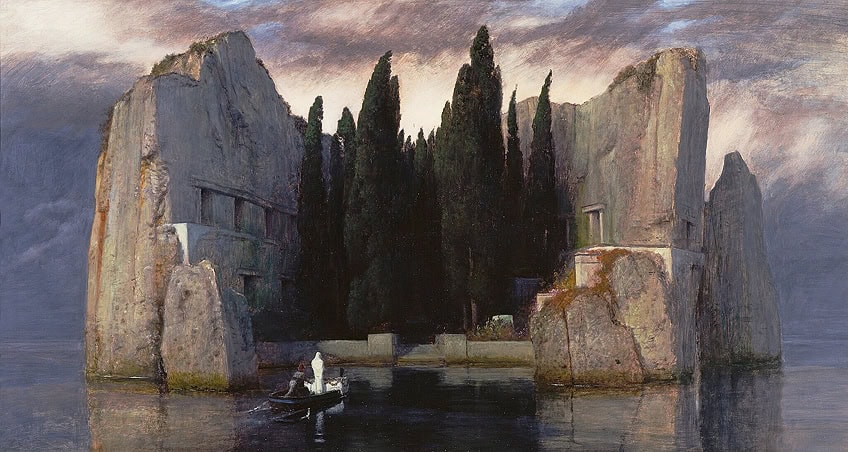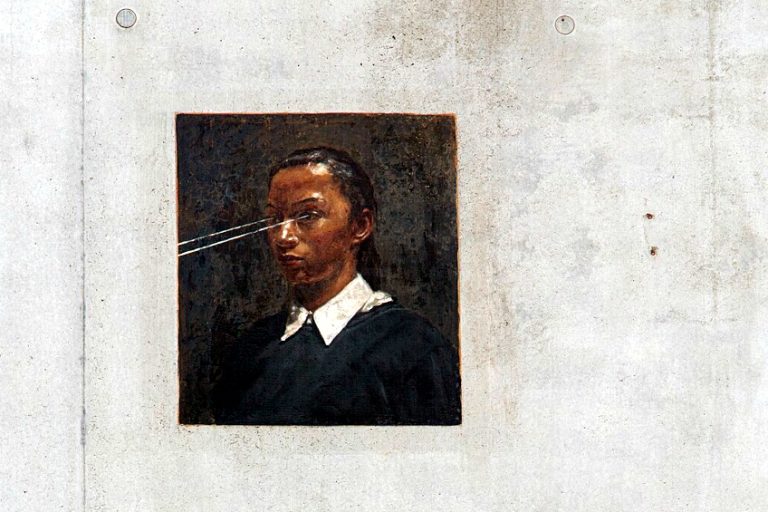Arnold Böcklin – The Painter of Legends
Arnold Böcklin was a Swiss symbolist painter whose works deeply influenced the development of Symbolism and Surrealism in the late 19th and early 20th centuries. Known for his fantastical and mysterious landscapes, Böcklin’s paintings often depicted mythological themes, dreamlike scenes, and symbolic figures, reflecting his fascination with the subconscious and the supernatural. His iconic work, Isle of the Dead, has become one of the most renowned images in art history, captivating viewers with its haunting beauty and enigmatic symbolism. Böcklin’s unique artistic vision continues to inspire artists and scholars, leaving a lasting legacy in the realm of symbolic art.
Key Takeaways
- Arnold Böcklin was a notable Swiss Symbolist painter.
- His works like Isle of the Dead blend Romantic, Symbolist, and Renaissance styles.
- Böcklin’s influence extends to modern artists and continues to inspire.
Early Life and Education
| Birth | October 16, 1827 |
|---|---|
| Death | January 16, 1901 |
| Place of Birth | Basel, Switzerland |
| Genre of Work | Symbolism, Romanticism, and Mythological art |
Arnold Böcklin was a Swiss Symbolist painter born in 1827, best known for his evocative and mysterious works that blend Romanticism and Symbolism. His compelling paintings often feature mythological and allegorical themes, capturing the imagination of viewers with their dramatic and haunting qualities. Böcklin’s most famous work, Isle of the Dead, has had a profound influence on many modern artists such as de Chirico and Dalí. Böcklin’s artistic journey started with academic training but soon evolved into creating unique pieces that merged various styles.

His paintings, such as Battle of the Centaurs and Self-Portrait with Death Playing the Fiddle, display a mix of Romantic, Symbolist, and Renaissance influences. These works showcase his versatility and eclecticism, making him a standout figure in the art world. His moody landscapes and sinister allegories, like Odysseus and Calypso, have significantly impacted late 19th-century German artists and symbolism. Böcklin’s legacy continues to inspire contemporary art and culture, cementing his place as a pivotal figure in Swiss Symbolism and beyond.
Studies at Düsseldorf Academy
Arnold Böcklin started his formal education at the Düsseldorf Academy in Germany. Directed by Johann Wilhelm Schirmer, the academy was known for promoting Romanticism, which left a lasting impression on Böcklin. At Düsseldorf, he became friends with Anselm Feuerbach, another notable painter of the era. Here, his skills in landscapes and human figures began to take form.
These studies provided him a strong foundation in traditional techniques and stylistic approaches that influenced his later work.
Influence of German Artists and Romanticism
While at Düsseldorf, Böcklin was exposed to the works of German Romantic artists. His time at the academy opened his eyes to new styles and techniques, especially those related to themes of nature and emotion. This period was crucial in developing his style, marked by moody landscapes and mythological subjects. The Romantic movement, with its emphasis on individualism and beauty, molded his artistic vision and led him to create works filled with symbolic meaning and supernatural elements.

Mature Period
In his mature period, Böcklin continued to build on the lessons he learned in his early studies. He traveled across Europe, including stays in Antwerp and Paris, absorbing diverse influences that enriched his art. His works from this era feature intricate details and a blend of natural and fantastical elements. Paintings like Island of the Dead reflect his mastery in creating evocative and allegorical imagery.
This period solidified his reputation as a leading artist in the Symbolist movement.
Later Period and Death
In his later years, Böcklin’s art did not lose its vigor. He continued to produce significant works and maintain a strong presence in the art world. His life came to a close on January 16, 1901, in Fiesole, Italy. This period was marked by a reflection on his earlier themes, as he revisited many ideas from his youth. His enduring influence on European art is evident in the continued interest and study of his works. His legacy lives on, particularly in his moody landscapes and allegorical compositions.

Major Works and Artistic Style
Arnold Böcklin, a Swiss Symbolist painter, created art that fused landscapes with mythological and allegorical themes. His works are known for their deep symbolism and dramatic interpretations.
Artistic Accomplishments
Arnold Böcklin achieved significant success as a painter during the 19th century. His body of work includes paintings, drafts, sculptures, and graphic art. Böcklin’s paintings covered various themes and evolved from naturalism to more symbolist and surrealist elements, portraying human emotions, life, death, and mythological subjects. One of his notable accomplishments was holding a major retrospective in Basel in 1897, which solidified his position in European art history.

Symbolist Themes in Böcklin’s Paintings
Böcklin’s paintings are characterized by their strong symbolist themes. His work often includes mythological and allegorical elements. These depictions were unconventional at the time and captured the imagination of viewers. His renowned work, Isle of the Dead, exemplifies this with its mysterious and somber atmosphere, often interpreted as an exploration of death and the afterlife. The use of classical architecture and heroic landscapes adds a timeless quality to his pieces.
Böcklin’s style influenced later surrealist painters, who admired his ability to merge reality with fantastical elements.
Famous Paintings and Their Significance
Arnold Böcklin produced several famous paintings that are celebrated for their depth and creativity. Isle of the Dead is perhaps his most well-known work, painted in several versions from 1880 to 1886. This piece remains iconic for its haunting solitude and profound symbolism.

Another significant painting is Playing in the Waves (1883), which shows a more lighthearted and dynamic side of his work. This painting is a vivid depiction of mythological creatures playing in the sea, illustrating his skill in capturing movement and emotion. His works, like Triton and Nereid and Villa by the Sea, also highlight Böcklin’s mastery in blending mythological themes with stunning landscape backgrounds.
Cultural Impact and Legacy
Arnold Böcklin’s artistic influence extended beyond painting. His works shaped the visions of composers and artists alike, cementing his place in art history and leaving a lasting legacy today.
Influence on Composers and Artists
Böcklin’s paintings had a significant impact on the works of many composers and artists. Sergei Rachmaninoff, a renowned composer, created a symphonic poem titled Isle of the Dead inspired by Böcklin’s painting of the same name. This piece captures the haunting and mystical qualities of Böcklin’s work. Artists like Salvador Dalí and Giorgio de Chirico were also heavily influenced by Böcklin.

Dalí’s surreal landscapes and eerie atmospheres borrow elements directly from Böcklin’s style. De Chirico, known for his metaphysical paintings, often incorporated ghostly and dreamlike themes that echo Böcklin’s influence. Max Ernst, a leading figure in the Dada and Surrealist movements, admired Böcklin’s imaginative and symbolic approach. Ernst’s use of fantastical elements and symbolism in his works shows a clear lineage to Böcklin’s influence.
Böcklin’s Place in Art History
Böcklin is regarded as a central figure in the Symbolist Movement. His moody landscapes and allegorical themes reflect the Symbolist emphasis on representing emotion, mystery, and the subconscious. By integrating mythological and fantastical elements, he set a precedent for later movements such as Metaphysical and Surrealist art.
His unique ability to blend reality with the imaginary placed him as a bridge between 19th-century Romanticism and 20th-century modernism.
This transition helped shape the direction of European art, making him an essential link in the evolution of artistic styles. His work, often misunderstood, challenged contemporary notions and helped pave the way for future avant-garde movements, ensuring his position in the annals of art history.
Legacy of Arnold Böcklin Today
Today, Böcklin’s legacy continues to be felt in various fields. His paintings are displayed in major art museums around the world, such as the Alte Nationalgalerie in Berlin. Academics and art enthusiasts study his work for its deep symbolism and technical mastery.

Modern artists still draw inspiration from Böcklin’s techniques and thematic elements. His influence is evident in contemporary fantasy and surrealist art, where the lines between reality and imagination are often blurred. Arnold Böcklin’s work remains a subject of great interest and admiration, continually inspiring new generations to explore the boundaries of art. His visionary approach ensures that his contributions to art will not be forgotten.
Arnold Böcklin’s artistic legacy remains a significant influence on the realms of Symbolism, Surrealism, and fantasy art. His mastery in depicting the subconscious, mythological narratives, and mysterious landscapes continues to captivate audiences worldwide. Böcklin’s ability to merge the real with the imagined, and the known with the fantastical, has solidified his place as a visionary artist whose works transcend time and inspire generations of artists to explore the depths of human imagination and symbolism in art.
Frequently Asked Questions
What Are the Defining Characteristics of Arnold Böcklin’s Artistic Style?
Arnold Böcklin’s paintings often feature moody landscapes and mythological themes. His works are known for their dark, mystical quality and dramatic use of color. He frequently incorporated symbolic elements, blending fantasy and reality in his compositions.
Which Museum Houses the Largest Collection of Arnold Böcklin’s Works?
The largest collection of Arnold Böcklin’s works can be found at the Kunstmuseum Basel in Switzerland. This museum holds a substantial number of his paintings, reflecting his strong ties to his birthplace and his prominent role in Swiss art history.
How Did Arnold Böcklin’s Work Influence the Symbolist Movement?
Arnold Böcklin’s influence on the Symbolist movement was profound. His use of allegory and mythological subjects paved the way for the movement’s exploration of deeper symbolic meanings. Böcklin’s work inspired late 19th-century German artists and contributed to the development of Metaphysical and Surrealist art in the 20th century.
Isabella studied at the University of Cape Town in South Africa and graduated with a Bachelor of Arts majoring in English Literature & Language and Psychology. Throughout her undergraduate years, she took Art History as an additional subject and absolutely loved it. Building on from her art history knowledge that began in high school, art has always been a particular area of fascination for her. From learning about artworks previously unknown to her, or sharpening her existing understanding of specific works, the ability to continue learning within this interesting sphere excites her greatly.
Her focal points of interest in art history encompass profiling specific artists and art movements, as it is these areas where she is able to really dig deep into the rich narrative of the art world. Additionally, she particularly enjoys exploring the different artistic styles of the 20th century, as well as the important impact that female artists have had on the development of art history.
Learn more about Isabella Meyer and the Art in Context Team.
Cite this Article
Isabella, Meyer, “Arnold Böcklin – The Painter of Legends.” Art in Context. July 11, 2024. URL: https://artincontext.org/arnold-bocklin/
Meyer, I. (2024, 11 July). Arnold Böcklin – The Painter of Legends. Art in Context. https://artincontext.org/arnold-bocklin/
Meyer, Isabella. “Arnold Böcklin – The Painter of Legends.” Art in Context, July 11, 2024. https://artincontext.org/arnold-bocklin/.











